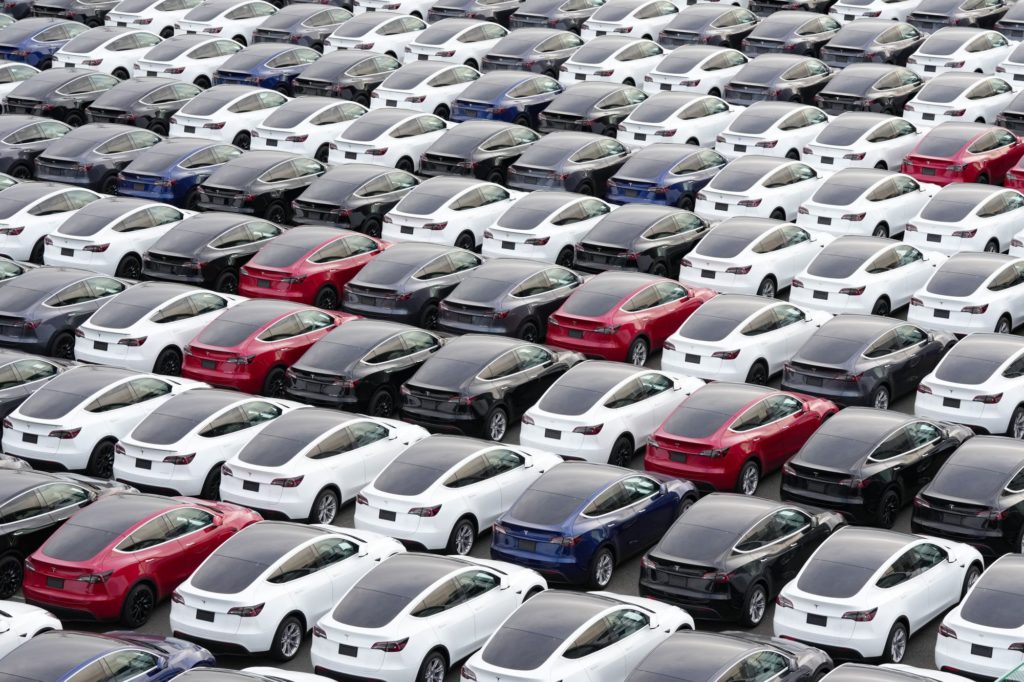Tesla Inc. shares fell more than 14% after the electric carmaker delivered fewer vehicles than expected last quarter despite offering hefty incentives in its biggest markets.
(Bloomberg) — Tesla Inc. shares fell more than 14% after the electric carmaker delivered fewer vehicles than expected last quarter despite offering hefty incentives in its biggest markets.
The company said Monday it handed over 405,278 vehicles to customers in the last three months, short of the 420,760 average estimate compiled by Bloomberg. While the total was a quarterly record for Tesla, the company opened two new assembly plants last year and still came up short of its goal to expand by 50%.
It’s also the third straight quarter that deliveries have missed estimates. Several analysts cut price targets on the stock Tuesday, resulting in Tesla’s lowest average 12-month stock forecast since October 2021. And JPMorgan Chase & Co. said Tesla might never again reach its multi-year 50% growth sales objective.
“Our base case assumption is that year-on-year growth (while remaining impressive overall) is likely to decline each year from here on out,” analyst Ryan Brinkman, who has the equivalent of a sell rating on the shares, wrote in a research note.
Tesla’s double-digit decline to $105.60 just before 12:00 p.m. in New York — the steepest drop since September 2020 — comes on the heels of a dismal 2022 for the stock. In December, its shares plunged 37% and closed out the year with a record 65% tumble.
After Chief Executive Officer Elon Musk predicted an “epic” end to the year, Tesla cut vehicle prices and production in China, then offered $7,500 discounts in the US. Concerns about rising interest rates, inflation and other economic headwinds — plus alarm over Musk’s antics on Twitter, which he now owns — sent Tesla shares plunging 37% in December and 65% last year.
“We believe that Tesla is facing a significant demand problem,” Toni Sacconaghi, a Bernstein analyst who also has the equivalent of a sell rating on the stock, wrote in a report Monday. “We believe Tesla will need to either reduce its growth targets (and run its factories below capacity) or sustain and potentially increase recent price cuts globally, pressuring margins.”
Read more: Tesla Stock Had the Worst Year Ever. That Doesn’t Make It Cheap
Tesla increased deliveries by 40% to 1.31 million last year, shy of the 50% average annual growth rate the company has said it expects to achieve over multiple years. Production expanded 47% to 1.37 million.
The company produced 439,701 vehicles in the fourth quarter, exceeding deliveries by 34,423 units. Tesla said that it continued to transition to “a more even regional mix of vehicle builds,” which led to another increase in cars in transit at the end of the quarter.
“Tesla sells cars, and the auto industry is slowing down,” Gene Munster, managing partner of Loup Ventures, said by phone. “They are still struggling with logistics, and the gap between production and deliveries grew from the last quarter.”
Musk said during Tesla’s last earnings call that Tesla was trying to “smooth out” deliveries throughout each quarter so that the company no longer has a wave of handovers concentrated at the end of each period. Design chief Franz von Holzhausen nonetheless tweeted that he pitched in at a southern California delivery center on New Year’s Eve.
The discounts Tesla offered in the US toward the end of the quarter matched the maximum tax credit that electric vehicles are eligible for under the Inflation Reduction Act that President Joe Biden signed in August. The carmaker suffered a setback in this regard late last month when the Internal Revenue Service published a list of electric and plug-in hybrid vehicles that are eligible for federal tax credits.
Most of Tesla’s models won’t qualify under current interpretations of the law because they are either too expensive or use batteries that aren’t fully compliant. The only vehicle likely to pass muster is the seven-seat version of the Model Y, which means “consumers may have to order and spend an extra $3000 for a third row they don’t want/need on the Model Y to qualify for a tax credit,” said Bernstein’s Sacconaghi.
Musk took issue with the IRS’ eligibility list in several tweets, writing “this is messed up” on Jan. 1 and questioning Monday whether the company was being penalized for making the Model Y too mass-efficient.
Tesla doesn’t break out sales by region, but the US and China are its largest markets, and 95% of sales in 2022 were of the Model 3 sedan and Y crossover.
The company makes the Model S, X, 3 and Y at its factory in Fremont, California. Its Shanghai plant produces the Model 3 and Y, and it started delivering Model Ys from its newest plants in Austin and near Berlin in the first half of last year.
While Musk handed over Tesla’s first Semi trucks to PepsiCo Inc. in December, the company didn’t report any deliveries of the model in its quarterly statement. The carmaker announced separately that it’s scheduled an investor day for March 1, where it will discuss long-term expansion plans, a next-generation vehicle platform, capital allocation and other subjects.
Some analysts are cautiously optimistic. For Truist analyst William Stein, now might be the time to buy the dip. “Long-term investors should keep their eye on the prize and buy TSLA,” he wrote in a report. Still, he reduced his price target to $299 from $348.
–With assistance from Craig Trudell, Subrat Patnaik and Divya Balji.
(Updates share price move throughout and adds more details.)
More stories like this are available on bloomberg.com
©2023 Bloomberg L.P.










